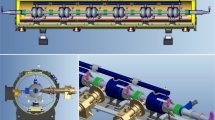Abstract
Very high frequency (VHF) photocathode guns have excellent performance and are being increasingly selected as electron sources for high-repetition-rate X-ray free-electron lasers. As a highly loaded quality factor cavity, the VHF gun requires high stability in the amplitude and phase of the cavity field. However, the gun is microwave powered by two solid-state power sources through two separate power couplers. The input difference between the two power couplers will influence the stability of the cavity field. To systematically study this influence and obtain measurement formulae, a multi-port VHF gun LCR circuit model is built and analyzed. During the warm-up condition, the cavity structure will be deformed due to the large-scale change in the cavity temperature. Then, the deformation will result in cavity resonant frequency changes. To prevent the mechanic tuner from suffering damages due to the frequent and long-distance movement for correcting the cavity resonant frequency, a self-excited loop (SEL) control system is considered for changing the loop phase and make the loop frequency follow the resonant frequency. In this study, a steady-state model of the VHF gun cavity is built for obtaining the optimal input coupler coefficient and the stability requirement of the forward voltage. Then, the generator-driven resonator and SEL control system, which combine with the VHF multi-port modeling, are modeled and simulated. The simulated results show that the SEL system can perfectly operate in the process of condition and warm-up.









Similar content being viewed by others
References
F. Sannibale, D. Filippetto, C.F. Papadopoulos et al., Advanced photoinjector experiment photogun commissioning results. Phys. Rev. Spec. Top. Accel. Beams 15, 103501 (2012). https://doi.org/10.1103/PhysRevSTAB.15.103501
F. Sannibale, B. Bailey, K. Baptiste et al., Status of the APEX project at LBNL, in Paper Presented at the 5th International Particle Accelerator Conference (Dresden, Germany, 2014), pp. 15–20
J.F. Schmerge, A. Brachmann, D. Dowell et al., The LCLS-II injector design, in Paper Presented at the 36th International Free Electron Laser Conference (Basel, Switzerland, 2014), pp. 25–29
R. Huang, D. Filippetto, C.F. Papadopoulos et al., Dark current studies on a normal-conducting high-brightness very-high-frequency electron gun operating in continuous wave mode. Phys. Rev. Spec. Top. Accel. Beams 18, 013401 (2015). https://doi.org/10.1103/PhysRevSTAB.18.013401
G. Huang, K. Campbell, L. Doolittle et al., LCLS-II gun/buncher LLRF system design, in Paper Presented at the 9th International Particle Accelerator Conference, (Vancouver, Canada, 29 April–4 May 2018)
H.J. Qian, M. Krasilnikov, F. Stephan, A cryocooled normal-conducting and superconducting hybrid CW photoinjector, in Paper Presented at the 38th International Free Electron Laser Conference (Santa Fe, USA, 2017), pp. 20–25
S. Noguchi, E. Kako, M. Sato et al., KEK ERL cryomodule development, in Paper Presented at the 50th ICFA Advanced Beam Dynamics Workshop on Energy Recovery Linacs (New York, USA, 2009), pp. 8–12
K. Watanabe, S. Noguchi, E. Kako et al., Development of the superconducting RF 2-cell cavity for the cERL injector at KEK. Nucl. Instrum. Methods A 714, 67 (2013). https://doi.org/10.1016/j.nima.2013.02.035
A. Neumann, M. Abo-Bakr, W. Anders et al., Booster cavity and fundamental power coupler design issues for bERLinPro, in Paper Presented at the 5th International Particle Accelerator Conference (Dresden, Germany, 2014), pp. 15–20
M.D. Li, Y.B. Zhao, X. Zheng et al., Design and implementation of frequency tracking and amplitude-phase feedback in RFQ low level control system. Nucl. Tech. 41, 060202 (2018). https://doi.org/10.11889/j.0253-3219.2018.hjs.41.060202. (in Chinese)
Z. Fang, T. Kobayashi, Y. Fukui et al., Auto-tuning systems for J-PARC LINAC RF cavities. Nucl. Instrum. Methods A 767, 135 (2014). https://doi.org/10.1016/j.nima.2014.08.014
J. Delayen, in Self-excited Loop. Jefferson Lab LLRF Workshop. https://www.jlab.org/intralab/calendar/archive01/LLRF/Delayen.pdf. Accessed 25 April 2001
T. Allison, J. Delayen, C. Hovater et al., A digital self excited loop for accelerating cavity field control, in Paper Presented at the 2007 IEEE Particle Accelerator Conference (Albuquerque, USA, 2007), pp. 25–29
J. Delayen, Phase and Amplitude Stabilization of Superconducting Resonators, Ph.D. Thesis, California Institute of Technology (1978)
S. Simrock, Achieving phase and amplitude stability in pulsed superconducting cavities, in Paper Presented at the 2001 Particle Accelerator Conference (Chicago, USA, 2001), pp. 18–22
C. Hovater, P. Chevtsov, J. Delayen, RF system development for the CEBAF energy upgrade, in Paper Presented at the Proceedings of LINAC 2002 (Gyeongju, Korea, 2002), pp. 19–23
C. Hovater, RF control of high \(Q_L\) superconducting cavities, in Paper Presented at the Proceedings of LINAC 2008, (Victoria, Canada, 29 September–3 October 2008)
T. Schilcher, Vector Sum Control of Pulsed Accelerating Fields in Lorentz Force Detuned Superconduncting Cavities, Ph.D. Thesis, Universitt Hamburg (1998)
A. Sun, H.P. Wang, Superconducting RF cavity measurement formulae for an exponential decayed pulse incident power, in Paper Presented at the 12th International Workshop On RF Superconductivity (New York, USA, 2005), pp. 10–15
L. Chen, S.H. Zhang, M.Y. Li et al., Room-temperature test system for 162.5 MHz high-power couplers. Nucl. Sci. Tech. 30, 7 (2019). https://doi.org/10.1007/s41365-018-0531-9
W.B. Wu, K. Xuan, W. Xu et al., Development of a control system for the fourth-harmonic cavity of the HLS storage ring. Nucl. Sci. Tech. 29, 153 (2018). https://doi.org/10.1007/s41365-018-0497-7
F. Qiu, S. Michizono, T. Miura et al., Real-time cavity simulator-based low-level radio-frequency test bench and applications for accelerators. Phys. Rev. Spec. Top. Accel. Beams 21, 032003 (2018). https://doi.org/10.1103/PhysRevAccelBeams.21.032003
S.S. Sun, J.Q. Zhang, L. Li et al., Linearization of the input and output characteristic curve of a klystron for SXFEL. Nucl. Tech. 40, 060102 (2017). https://doi.org/10.11889/j.0253-3219.2017.hjs.40.060102. (in Chinese)
S. Li, J.Q. Zhang, M. Zhang et al., Implementation of FPGA-based feedforward function in LLRF system for electron LINAC. Nucl. Tech. 39, 070402 (2016). https://doi.org/10.11889/j.0253-3219.2016.hjs.39.070402. (in Chinese)
G. Joshi, P. Singh, V. Agarwal et al., Digital self-excited loop for a superconducting linac. Nucl. Instrum. Methods A 762, 70 (2014). https://doi.org/10.1016/j.nima.2014.05.115
Acknowledgements
The authors are very grateful to Dr. Qiu Feng from KEK for his assistance in the self-excited loop modeling and simulations.
Author information
Authors and Affiliations
Corresponding authors
Rights and permissions
About this article
Cite this article
Liu, K., Li, L., Wang, C. et al. Multi-port cavity model and low-level RF systems design for VHF gun. NUCL SCI TECH 31, 8 (2020). https://doi.org/10.1007/s41365-019-0711-2
Received:
Revised:
Accepted:
Published:
DOI: https://doi.org/10.1007/s41365-019-0711-2




